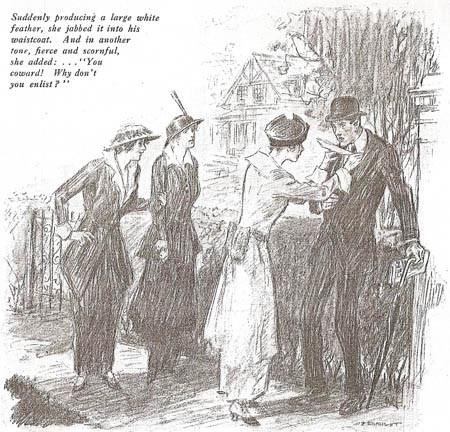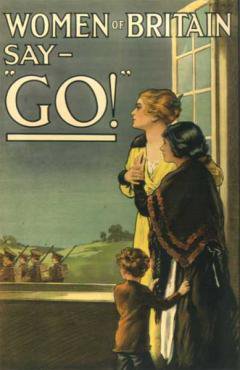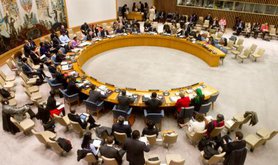
Image from 'The White Feather: A Sketch of English Recruiting' by Arnold Bennett, Collier’s Weekly 1914In 1914 and '15, notorious bands of women roamed the cities of England giving white feathers of cowardice to men wearing civilian clothes. Why would so-called 'white feather girls' wish to humiliate men not in uniform? This question has puzzled feminists for 100 years, since the first feathers of World War I were pinned to the lapels and hatbands of young men by disdainful flappers wishing them to enlist in the army. The 'White Feather Brigade' was established in Folkstone by Admiral Charles Penrose Fitzgerald, an ardent war-supporter who wished to see Britain institute mandatory military service. His idea spread through the country with astonishing rapidity. As young women combed beaches, high streets, trams, theaters, and places of resort, pinning tiny white feathers to men casually strolling or socializing with their friends, they sent shock waves through society. Not only were those men pinned with the mocking 'Order of the White Feather' profoundly humiliated, but commentators began to decry the immodesty of forward young women who had the audacity to insult perfect strangers and tell men what to do. Remarkably, the recollections of male victims suggest that they continued to feel this stain upon their honor well into old age. Why would women use their sexual power to shame men into the army when their pacifist sisters were meeting, organizing, and in 1915, braving great danger to travel to The Hague, with precisely the opposite aim: to stop the war?
The Order of the White Feather raises interesting questions about women’s response to the Great War. For pacifist feminists, ranging from Sylvia Pankhurst to Virginia Woolf, as well as the many rank and file members of the Women’s International League of Peace and Freedom, the obvious feminist position on war was to be against it. Yet, to fully understand the dynamics behind the white feather campaign, we need to recognize the range of both feminist and feminine response to war and to examine why those militarist women who supported the conflict might have chosen the path they did.

Poster issued in 1915 by the British Parliamentary Recruiting CommitteeThe Great War split the feminist movement with seismic violence. Despite a multiplicity of philosophical differences among pre-war suffragists, most had been united in their opposition to war. Yet, in 1915, the National Union of Women’s Suffrage Societies (NUWSS) – Britain’s largest suffrage organization – expelled its pacifist members as Millicent Fawcett admonished her followers to 'show ourselves worthy of citizenship, whether our claim to it be recognized or not.' Meanwhile, the Women’s Social and Political Union (WSPU) turned itself into a junta of pro-war militants, distinguished by an enthusiasm for war that rivalled the radical right. Indeed, the confluence between the ideology of the WSPU and the actions of the white feather girls was so striking that Christabel Pankhurst’s pacifist sister, Sylvia, even surmised that the two groups were one and the same. While the extraordinary war enthusiasm of both the WSPU and the white feather girls has made them objects of peculiar, and often horrified, curiosity, uncovering the sources of their radical nationalism offers insight into the pro-war sentiments of many more moderate women who, during World War I, repudiated the pacifist cause.

World War I, US propaganda posterWhy would feminists split over the question of peace, a value that had once stood at the heart of the suffrage movement? First, the representation of the war itself was carefully designed to appeal to women. The brutal German invasion of Belgium in August 1914 was immediately characterized as a 'rape', and graphic images of sexual assault and the torture of women and children began to pour out of the occupied territories, gaining primacy as Britain’s ostensible reason for entering the war. Like news of mass rape in Darfur, Taliban femicide, or the kidnapping of Nigerian School girls, the 'Rape of Belgium' brought forth evocative images of women in danger and electrified world opinion in favor of a war with complex causes that were difficult for feminists to oppose.
As pacifism grew in power after the war, atrocity stories were increasingly cast into doubt. If accounts of German 'barbarism' had little basis in reality, the slaughter of millions of idealistic young men appeared catastrophic and senseless. While new scholarship suggests that the Germans terrorized invaded populations and precipitated a refugee crisis of enormous magnitude, the invention of 'propaganda' as a sociological concept in the 1930s nevertheless fostered the growing reputation of World War I as a futile waste of life. If we consider that the feminist militarists of World War I believed what they read in the press, and that more of it was true than we once believed, their nationalism becomes more comprehensible. For many feminists who supported the Government war effort, the enemy was not the British military state, but the militarized masculinity of a rapacious German Army.
The war also opened up a host of opportunities for women. The Pankhursts sponsored gigantic parades demanding female admittance to union jobs, while engaging in a theatrical strike-breaking campaign in the North, where they argued that women workers would never 'down tools'. Similarly, the NUWSS raised and equipped women’s ambulance corps and hospital units, many of which were shipped to the front in an enduring spectacle of women’s bravery, patriotism, and capacity to aid in righteous war. As Radclyffe Hall’s fictional Stephen Gordon recognized, for many 'odd' women, competent, strong, and in Stephen’s case lesbian, the war finally offered a sense of true purposefulness.
Shrewd feminists like Pankhurst and Fawcett realized that patriotic sacrifice could greatly enhance women’s claim to citizenship as well. When the issue of franchise reform reemerged in 1916, the case for women’s suffrage was far more difficult to oppose. Not only were women loyally supporting the war effort, making munitions, and doing jobs formerly done by enfranchised men, but many were risking their lives as doctors, nurses, and ambulance drivers at the front. As press campaigns pilloried un-enlisted 'shirkers', they simultaneously praised women for their valiant contributions. Indeed, the Representation of the People Bill of 1918 not only re-enfranchised soldiers, but included female householders over thirty, under aged veterans, and military nurses, while disenfranchising conscientious objectors for seven years. Patriotism, rather than sex, was the new qualification for the vote.
Surely, however, such arguments meant little to the bands of teenage girls hopping cheekily onto buses and trams to offer white feathers. That many of them were slapped, pinched, knocked down or – most mortifyingly of all – confronted with a handless stump or footless leg, attached to a disabled veteran who had inadvertently been given a feather, should surely have dissuaded them from this irritating hobby. Why then did they continue to give out white feathers, even after the adoption of conscription in 1916? For some, the act was clearly a gesture of liberation and a moment of excitement and fun. One veteran claimed that he would go to the theatre district in the hope of getting a feather and then make off with the 'feather girl' once he had revealed he was a soldier. Stories in women’s magazines played on this trope, offering fictional tales of white feather girls whose “pluck” brought them into the arms of a heroic VC. As music hall stars sang 'We don’t want to lose you but we think you ought to go', and posters like 'Women of Britain, SAY GO!' shouted from hoardings, daring girls felt increasingly entitled to echo these themes to the flesh-and-blood men lingering in their midst.
If some women were looking for a bit of fun as they policed the boundaries of acceptable masculine behavior, others were clearly just angry at those men who refused to serve. The contempt many white feather-givers felt for the un-enlisted can be read in the anonymous letters that were often enclosed with a feather sent through the mail. A Bath railway porter was invited by a girl scout troop to come join them, as washer up; a conscientious objector seeking exemption was called a 'trench dodger' and a 'Chicken heart', while an underage boy was sent a feather and told to wear 'a frilly white dress'. For women, some of whom had probably been subject to harassment or hoots from men as they travelled on trams or walked home from work, the opportunity to harass and shame men in return must have been somewhat tempting.
Sadly, women had more to gain from supporting the war than from opposing it. As feminist pacifists were pilloried as 'cranks', and Sylvia Pankhurst found herself pelted with paint and rotten fruit by angry soldiers who objected to her peace meetings, militarists like Emmeline and Christabel Pankhurst became darlings of the conservative press and even received the coupon of coalition endorsement when Christabel stood for Parliament in the famous Khaki Election of 1918. Partial though the suffrage victory was, it opened the door to an equal franchise ten years later, and temporarily eclipsed the achievements of those women who had striven for peace.
As the guns quieted in November 1918, and the war receded into a nightmarish memory for those who served, the price of the dead hardly seemed worth the chimerical victory consolidated at Versailles. Haunted by the apparent futility of the Great War, we as feminists have understandably celebrated our pacifist sisters while conveniently forgetting the militant history of those feminist war-supporters who helped force open the door of the parliamentary vote. Only if we understand them too – with their calculation, their boldness and their ability to win the approval of powerful men -- will we recognize the allure of right wing causes for Conservative women who wish to share political power without challenging the social values that have helped bring about war. Feminist pacifists in western democracies may have an even greater challenge than striving for gender equality: we must make the cause of permanent peace more desirable than the siren-call of popular nationalism, which has so long led both men and women into tragic events like the now ironically remembered, “War to End all Wars.”
Read more
Get our weekly email





Comments
We encourage anyone to comment, please consult the oD commenting guidelines if you have any questions.